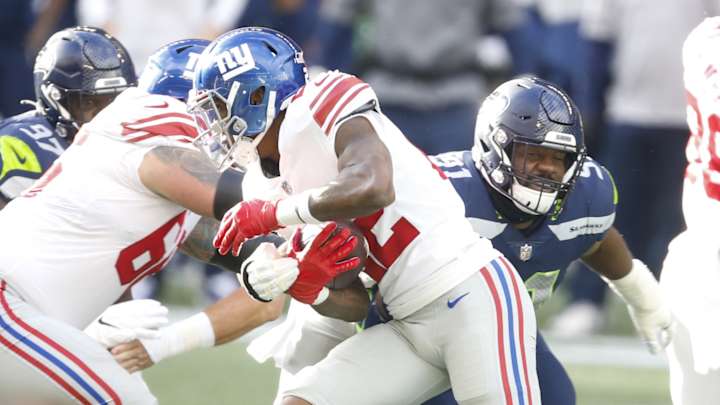Why the Giants Running Game Has Found Success After Losing Saquon Barkley

When Giants running back Saquon Barkley was lost for the season after just five quarters of play this year, it was widely feared that the Giants running game would be finished as well.
That hasn't been the case, though, as the Giants ground game has not only functioned without Barkley, it's done so in convincing fashion with a group of players that are nowhere near the talent level of Barkley.
In their last seven games, the Giants have run for over 100 yards as a group. And in their previous four games, which just so happens to coincide with their winning streak, the Giants have run for some o their highest single-game totals this year, including 166, 151, 142, and a season-high 190 yards.
What's been the reason for the Giants' success? Obviously, credit goes to the running backs who have worked on a rotation--Wayne Gallman, Dion Lewis, and Alfred Morris have taken the bulk of the carries with fullback Eli Penny getting a sprinkling of reps here and there.
And obviously, the offensive line's run-blocking has improved significantly, even though head coach Joe Judge likes to deploy a rotation at both the guards and tackles.
But the most significant catalyst behind the Giants run game surge has been the use of 12-personnel--one running back and two tight ends--over the more traditional 11-personnel (one running back, one tight end) set.
According to PFF, the Giants have run 334 snaps this season in 12-personnel, their second most popular personnel grouping behind 11-personnel (894 snaps).
When running 12-personnel, the Giants have averaged 5.6 yards per carry in the rushing game versus the 5.0 yards per carry they've averaged when running 11-personnel.
- READ: New York Giants: Biggest Storylines Ahead of Week 14
An extra tight end allows the Giants to add some extra beef upfront that helps them win the battle at the point of attack and move the chains.
"We like to use different personnel groups," said offensive coordinator Jason Garrett, whose next most frequent personnel grouping has been 13-personnel, on which they've averaged 3.4 yards per carry on 101 snaps.
"Thirteen has been a pretty good one for us all year long, both running and throwing it, and really probably has a lot to do with how much confidence we have in the tight ends."
The use of the "heavy" personnel groupings--12-, 13- and 21- and 22-personnel--gives Garrett options that he might not have with the more restrictive 11-personnel.
For instance, by running 22-personnel--two backs and two tight ends--there are more options regarding how they're deployed.
The added "beef' also helps the offensive line, which until a few weeks ago, started playing better, had struggled earlier in the season.
And it all starts with the tight ends, according to Garrett.
"You talk about Evan, you talk about Kaden (Smith) and Levine (Toilolo), those guys are really good football players. They’re good blockers," he said.
"When we throw to them in the passing game, typically they come through for us. You get in some different formations with that big personnel group that can cause some problems for the defense. The game the other day was about running the football. We tried to attack them a few different ways from those big personnel groups."
The use of 12-personnel has also served to mask some of the Giants receivers' deficiencies this year.
The Giants wideouts have combined for just 2,489 receiving yards this season on 248 receptions (10.0 yards per catch), the receiving yardage total being the fourth lowest in the NFL.
Their top three wideouts--Sterling Shepard, Golden Tate, and Darius Slayton--are all under 600 yards receiving a piece.
Between the receiving game's struggles and the loss of Barkley, switching to heavier sets has benefitted the Giants and has brought them back to playing power football, which they used to dominate in the days when they were good.
"We believe in it very strongly to be balanced and to attack different ways. We’ve run the ball a lot better here the last six or seven weeks. I think that’s helped our team. It’s helped our offense," Garrett said.
"The residual effect to your pass protection and your passing game I think can be a positive one. Then really throughout the team as well, instilling that mentality of toughness, time of possession is a big part of it. You’re always trying to do whatever you can do to help the team win. I think running the football allows you to do that."
Get the latest New York Giants news by joining our community. Click "Follow" at the top right of our SI Giants Country page. Mobile users click the notification bell. Follow us on Facebook.

Patricia Traina has covered the New York Giants for 30+ seasons, and her work has appeared in multiple media outlets, including The Athletic, Forbes, Bleacher Report, and the Sports Illustrated media group. As a credentialed New York Giants press corps member, Patricia has also covered five Super Bowls (three featuring the Giants), the annual NFL draft, and the NFL Scouting Combine. She is the author of The Big 50: The Men and Moments that Made the New York Giants. In addition to her work with New York Giants On SI, Patricia hosts the Locked On Giants podcast. Patricia is also a member of the Pro Football Writers of America and the Football Writers Association of America.
Follow Patricia_Traina